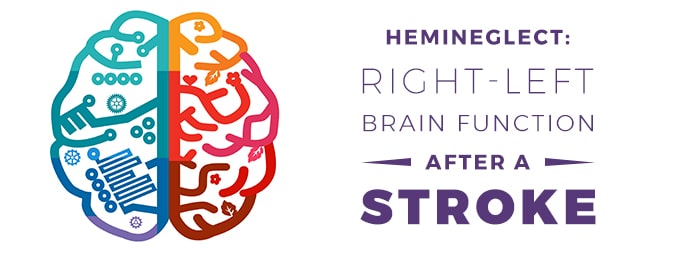Hemineglect: Right-Left Brain Function After a Stroke

The brain consists of two distinct halves, known as the right and left hemispheres. Each hemisphere is responsible for different tasks, including physically controlling the side of the body opposite it. When one hemisphere is damaged by a stroke, the brain may become unable to process or perceive what is occurring in and around the opposite side of the body. In severe cases, stroke patients may be unaware that their opposite side even exists and ignore it completely. This condition, known as hemineglect (also unilateral neglect, hemispatial neglect, or spatial neglect). Hemineglect is most prominent and lasts longer when a stroke damages the right side of the brain. However, damage may also occur on the left side of the brain, resulting in hemineglect on the right side of the body. As a matter of course, medical professionals test stroke patients to determine whether they are suffering from hemineglect.
What Is Hemineglect?
Hemineglect is characterized by reduced awareness of stimuli on one side of the body or in the space it inhabits, even though there may be no sensory loss. It may include the inability to process or perceive objects, people, and other stimuli. Sometimes, patients even ignore or disown their limbs on the affected side. Experts believe hemineglect occurs only when specific areas of the brain are damaged by a stroke. For example, the parietal lobe in the right hemisphere of the brain is involved with awareness of the space on both sides of the body, while the left parietal lobe only governs the right side. When the right parietal lobe is damaged, it can no longer attend to the left or right side of the body or the space it inhabits, but an intact left parietal lobe can still attend to the right side. That’s why the left side of the body is most often impacted by hemineglect. Patients who suffer from hemineglect may have some degree of paralysis, but limb weakness is not the cause of the condition. Many people with paralyzed limbs remain aware of both sides of their bodies and the surrounding space. However, those who suffer from hemineglect often appear to have increased limb weakness as well.How Is Hemineglect Diagnosed?
Generally, the right side of the brain coordinates tasks connected with creativity and the arts, such as spatial reasoning, musical comprehension, basic object recognition, emotion, and imagination. The left side of the brain is responsible for tasks that involve logic, such as science and math. Medical professionals test for the presence of neglect after a brain injury with a variety of mental tasks, including:- Inline Bisection. Patients are asked to mark the midpoint of a line that’s drawn across a page.
- Cancellation. Patients are given a page containing letters, lines, or symbols, and are asked to cross out specific items.
- Clock Drawing. Patients are asked to fill in the numbers on a clock face and designate a given time.
These tests enable professionals to determine the presence, location, and extent of hemineglect.
How Is Hemineglect Treated?
Sometimes the brain spontaneously recovers from hemineglect. Other times, it is necessary to retrain the brain to notice the neglected side of the body and surrounding space. Visual scanning tasks seem to be most successful in accomplishing this. Family members and caregivers can utilize the following activities to assist those suffering from hemineglect:- Cancellation. Create a set of letters or numbers and ask the person with neglect to find and cross out a specific item on the page. Encourage the patient to scan line by line, from left to right, and top to bottom.
- Reading. Put a bright line or colored tape down the left side of the pages of books, newspapers, or magazines. This indicates where the individual should start reading on a page and encourages reading from left to right.
- Mealtime. Sit on the patient’s affected side and ask for eye contact when they are speaking. Also place utensils on the neglected side.
- Visual Search. Place common objects in front of the patient, including on their affected side. Then ask them to find a specific item.
- Navigation. Walk around indoors or outdoors with the patient, asking them to look at and describe items on the affected side.
Patience Is the Key
Retraining the brain to respond to stimuli and relearn certain behaviors takes time. There is no way to predict how long it will take to recover from hemineglect. Consistency, repetition, and patience will bear the best results. Here at Saebo, we are committed to stroke support and recovery for all survivors and their families. Saebo offers a wide range of products that combine cutting-edge technology with evidence-based rehabilitation techniques. Our offerings and network of Saebo-trained therapists can help you or a loved one to obtain all the necessary tools to maximize stroke recovery. For More Information on Hemineglect, Visit: “How a Stroke in the Right Brain Affects the Body and How to Recover,” https://www.saebo.com/right-brain-stroke-recovery/All content provided on this blog is for informational purposes only and is not intended to be a substitute for professional medical advice, diagnosis, or treatment. Always seek the advice of your physician or other qualified health providers with any questions you may have regarding a medical condition. If you think you may have a medical emergency, call your doctor or 911 immediately. Reliance on any information provided by the Saebo website is solely at your own risk.



